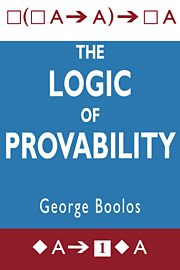Book contents
- Frontmatter
- Contents
- Preface
- Introduction
- 1 GL and other systems of propositional modal logic
- 2 Peano arithmetic
- 3 The box as Bew(x)
- 4 Semantics for GL and other modal logics
- 5 Completeness and decidability of GL and K, K4, T, B, S4, and S5
- 6 Canonical models
- 7 On GL
- 8 The fixed point theorem
- 9 The arithmetical completeness theorems for GL and GLS
- 10 Trees for GL
- 11 An incomplete system of modal logic
- 12 An S4-preserving proof-theoretical treatment of modality
- 13 Modal logic within set theory
- 14 Modal logic within analysis
- 15 The joint provability logic of consistency and ω-consistency
- 16 On GLB: The fixed point theorem, letterless sentences, and analysis
- 17 Quantified provability logic
- 18 Quantified provability logic with one one-place predicate letter
- Notes
- Bibliography
- Index
- Notation and symbols
4 - Semantics for GL and other modal logics
Published online by Cambridge University Press: 08 January 2010
- Frontmatter
- Contents
- Preface
- Introduction
- 1 GL and other systems of propositional modal logic
- 2 Peano arithmetic
- 3 The box as Bew(x)
- 4 Semantics for GL and other modal logics
- 5 Completeness and decidability of GL and K, K4, T, B, S4, and S5
- 6 Canonical models
- 7 On GL
- 8 The fixed point theorem
- 9 The arithmetical completeness theorems for GL and GLS
- 10 Trees for GL
- 11 An incomplete system of modal logic
- 12 An S4-preserving proof-theoretical treatment of modality
- 13 Modal logic within set theory
- 14 Modal logic within analysis
- 15 The joint provability logic of consistency and ω-consistency
- 16 On GLB: The fixed point theorem, letterless sentences, and analysis
- 17 Quantified provability logic
- 18 Quantified provability logic with one one-place predicate letter
- Notes
- Bibliography
- Index
- Notation and symbols
Summary
The semantical treatment of modal logic that we now present is due to Kripke and was inspired by a well-known fantasy often ascribed to Leibniz, according to which we inhabit a place called the actual world, which is one of a number of possible worlds. (It is a further part of the fantasy, which we can ignore, that because of certain of its excellences God selected the possible world that we inhabit to be the one that he would make actual. Lucky us.) Each of our statements is true or false in – we shall say at – various possible worlds. A statement is true at a world if it correctly describes that world and false if it does not. We sometimes call a particular statement true or false, tout court, but when we do, we are to be understood as speaking about the actual world and saying that the statement is true or false at it. Some of the statements we make are true at all possible worlds, including of course the actual world; these are the so-called necessary statements. A statement to the effect that another is necessary will thus be true if the other statement is true at all possible worlds. It follows that if a statement is necessary, then it is true. Some statements are true at at least one possible world; these are the possible statements.
- Type
- Chapter
- Information
- The Logic of Provability , pp. 68 - 77Publisher: Cambridge University PressPrint publication year: 1994



